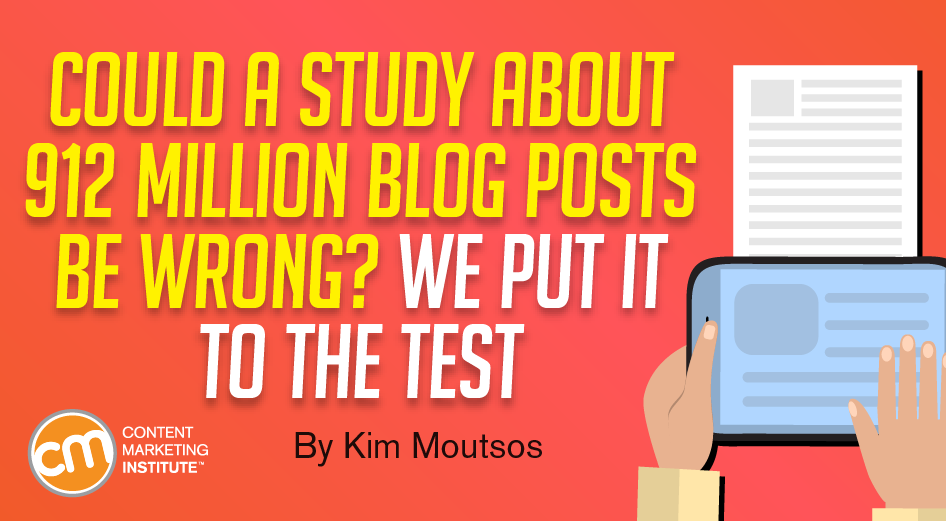The Content Marketing Institute audience isn’t your audience. To demonstrate this practice, I dug into Backlinko’s recent exploration of how factors such as blog format and length correlate with social media shares and backlinks among 912 million posts. To find out, I tested these Backlinko findings: 94% of all blog posts generate zero backlinks. Where to get the data The Backlinko research analyzed BuzzSumo data, so I headed there for CMI’s sharing and backlink totals. CMI average backlinks per blog post: 15.2 CMI average backlinks per post longer than 3,000 words: 19.8 Verdict: CMI’s long-form content did earn more backlinks than shorter content. Assertion: Blog posts of 1,000 to 2,000 words get the most social shares Most of the posts CMI published in 2018 fall into this range (77%). CMI average shares per article of 1,000 to 2,000 words: 672 CMI average shares per article (any length): 683 Verdict: Blog posts between 1,000 and 2,000 words do not get the most social shares at CMI. The average length of the 10% of posts attracting the most social shares is 1,762 words. My point is simply that using research based on a data set different from your data set is a great jumping-off point. You might not ask the same questions of your data that Backlinko asked of the BuzzSumo data.

If your mother says she loves you, check it out. Anyone with journalism training (or who knows anyone with journalism training) has heard this adage.
Despite its outdated view of parenting (Should we just believe what our fathers tell us? And did only mothers say they love their children?), verifying is a useful exercise when reviewing any best practices or research.
But wait, isn’t the point of best practices and research that other people have done the hard work of figuring out what works for you? Not exactly.
Best practices and research give you a starting place to explore what works in your situation.
Why must content marketers question everything?
You probably intuitively know the answer to this question. It’s because of the many nuances in audiences.
The Content Marketing Institute audience isn’t your audience. In fact, our audience isn’t even a single audience. We have a daily blog audience, an executive publication audience, a Content Marketing World audience, a ContentTECH Summit audience, and so on and so on. The makeup and behavior of each is a bit different. The makeup and behavior of your audience is different from any segment of ours. No two audiences are alike.
Does that mean research or best practices aren’t applicable? Of course not. But when you read research or guidance, check the findings against your audience before acting on it.
To demonstrate this practice, I dug into Backlinko’s recent exploration of how factors such as blog format and length correlate with social media shares and backlinks among 912 million posts. It’s a fascinating and worthy read that’s attracted nearly 4,000 shares and generated a great discussion in its comments.
But do the findings of that enormous sample drawn from sites with both B2B and B2C audiences hold up when applied to the 260 blog posts CMI published in 2018?
To find out, I tested these Backlinko findings:
- 94% of all blog posts generate zero backlinks.
- Long-form content averages 77.2% more links than short articles.
- Longer content outperforms short blog posts when it comes to social shares.
Where to get the data
The Backlinko research analyzed BuzzSumo data, so I headed there for CMI’s sharing and backlink totals. I set the date range of January 1, 2018 to December 31, 2018.

Then I clicked Export and chose the Excel format.
(I omitted 2019 posts because they hadn’t had time to earn shares and backlinks.)

Once I opened the file, I found that not all the statistics included came from the blog portion of our site, so I deleted any rows that didn’t relate to blog posts. I also hid several columns that held data I wouldn’t need for this analysis.
With my spreadsheet set, I dove into the comparison.
Assertion: 94% of all blog posts generate no external backlinks
Sorting by the number of referring domains, I could see at a glance that only one article earned a single backlink (and no blog posts earned zero links).
I also calculated the average number of backlinks as well as social shares per post and number of words per article. You can see how I set up the sheet (and a small selection of the data) in the image below.


COMMENTS